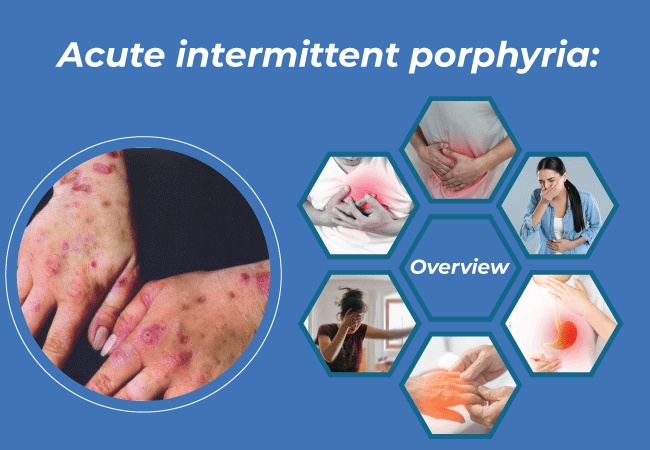Acute intermittent porphyria: Introduction:
Acute intermittent porphyria, also called AIP or Swedish Porphyria, is a rare autosomal dominant disease characterized by a hydroxymethylbilane synthase (HMBS) deficiency, also known as porphobilinogen deaminase (PBGD). This enzyme deficiency can result in the accumulation of porphyrin precursors in the body, which is toxic. However, the deficiency by itself is not sufficient to produce symptoms of the disease, and most people with an HMBS gene mutation do not develop symptoms of acute intermittent porphyria. Other factors such as hormonal changes, usage of certain drugs, infections, smoking, alcohol, and other reasons like change in diet may influence the symptoms to trigger the outlook.
Acute intermittent porphyria: Pathophysiology
Acute attacks of acute intermittent porphyria (AIP) are more common in women as it affects women more extensively than men, with a ratio of 1.5 and 2 to 1. Women in the post-puberty phase are more prone to AIP.
In acute intermittent porphyria, there is an aggregation of porphyrin precursors, porphobilinogen, and aminolevulinic acid (ALA). AIP is accompanied by neurological damage. A recent (2017) case-control study published by the National Library Of Medicine in 50 patients shows that AIP causes systemic inflammation. Storjord et al. found that insulin levels, C-peptide, prealbumin, and kidney function markers were decreased in symptomatic patients only, sparing the asymptomatic ones. They postulated that in symptomatic patients of AIP, reduced insulin release is associated with enhanced disease activity and compromised kidney function.
- Signs and symptoms accompanied by acute porphyria are:
- Severe abdominal pain
- Pain in your chest, legs, or back
- Constipation or diarrhea
- Nausea and vomiting
- Dysautonomia
- Depression
- Muscle pain, tingling, numbness, weakness, or paralysis
- Red or brown urine
- Mental changes, such as anxiety, confusion, hallucinations, disorientation, or paranoia
- Breathing problems
- Urination problems
- palpitations
- High blood pressure
- Seizures
Acute Intermittent Porphyria: Diagnosis
- Patients with confirmed AIP must be given a carbohydrate-rich diet and intravenously administered dextrose to induce hepatic ALAS1 transcription.
- 10% dextrose in 0.45% saline should start immediately administered.
- Morphine, diamorphine, and fentanyl are given as parenteral drugs to reduce pain if it occurs.
- Beta-blockers, angiotensin-converting enzyme inhibitors, and calcium channel blockers are given for tachycardia and hypertension.
- For specific therapy, administration of human hemin is done in a vein through a drip. It reloads the hepatocyte heme pool and down-regulates ALAS1, resulting in reduced production of porphyrin precursors and improving the symptoms.
Reference:-
bit.ly/3KjEdRh

